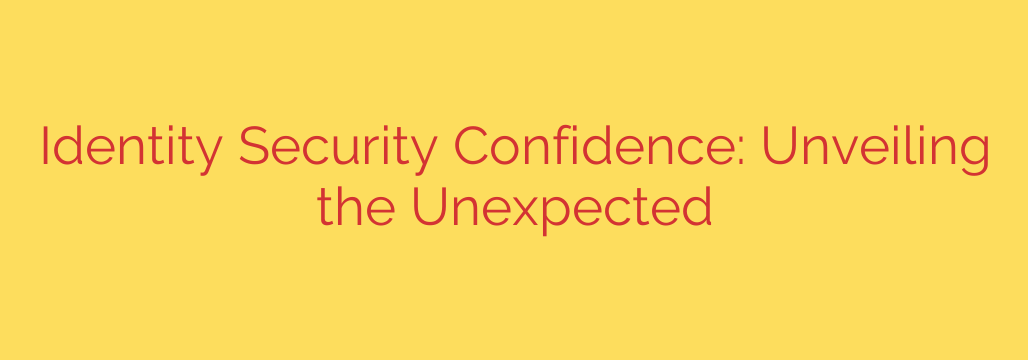
The Confidence Gap: Is Your Identity Security Weaker Than You Think?
In the world of cybersecurity, confidence can be a dangerous thing. Many business leaders and IT professionals believe they have a strong handle on their identity security protocols. They’ve invested in tools, set up policies, and checked the boxes on their compliance audits. Yet, a significant and often alarming gap exists between this perceived security and the stark reality of their vulnerabilities.
This “confidence gap” isn’t just a minor discrepancy; it’s a critical blind spot that threat actors are more than willing to exploit. The truth is, feeling secure and being secure are two very different things. Understanding the difference is the first step toward building a truly resilient defense against modern cyber threats.
Why Perception Doesn’t Match Reality
The illusion of strong security often stems from a surface-level view of protective measures. An organization might proudly state that it uses multi-factor authentication (MFA), but a deeper look reveals it’s only enforced for a fraction of its users or fails to cover critical administrative accounts. This creates a false sense of security while leaving major entry points wide open.
Key factors contributing to this dangerous overconfidence include:
- Tool Ownership vs. Implementation: Simply purchasing a security solution doesn’t automatically make you secure. Many organizations possess advanced identity management tools but fail to implement them comprehensively, leaving critical assets and identities unprotected.
- Focus on the Perimeter: Traditional security models focused on building a strong wall around the network. In today’s cloud-centric, remote-work environment, the perimeter is gone. Identity is the new perimeter, and if it isn’t secured, your walls are meaningless.
- “Checkbox” Security: Fulfilling compliance requirements is essential, but it is not a substitute for genuine security. Attackers don’t care if you’re compliant; they only care if you’re vulnerable.
Uncovering the Hidden Dangers in Your Network
When you peel back the layers of a typical corporate network, the findings can be shocking. The real risks aren’t always sophisticated, zero-day exploits; more often, they are basic failures in identity and access management hygiene.
Some of the most common and dangerous blind spots include:
- Stale and Orphaned Accounts: Employees leave, roles change, and projects end, but their digital identities often remain active. These forgotten accounts are pure gold for attackers, offering an easy, often unmonitored, way into your system.
- Unmanaged Service Accounts: The non-human identities used by applications and systems to communicate are frequently overlooked. They often have broad permissions and weak or static credentials, making them a prime target. Stale user accounts and unmanaged machine identities are often the weakest links, providing a direct and often untracked pathway for attackers.
- Permission Creep: Over time, employees accumulate access rights far beyond what their current role requires. This violation of the Principle of Least Privilege (PoLP) means that if their account is compromised, the attacker gains a much wider blast radius.
A single compromised identity—whether human or machine—is often all a threat actor needs. Once inside, they can move laterally across your network, escalate their privileges, and ultimately gain access to your most sensitive data and critical systems.
Actionable Steps to Bridge the Gap and Bolster Your Defenses
Moving from a state of false confidence to one of verified security requires a proactive and continuous approach. It’s about shifting from assumption to validation. Here are five essential steps to harden your identity security posture:
Conduct a Thorough Identity Audit. You cannot protect what you don’t know you have. Perform a complete discovery of all human and non-human identities across your entire environment—on-premises, in the cloud, and in SaaS applications. Identify and immediately deactivate or delete all stale and orphaned accounts.
Enforce the Principle of Least Privilege (PoLP). This is a foundational pillar of Zero Trust security. Rigorously review and revoke all unnecessary permissions, ensuring that every user and service account has only the bare minimum access required to perform its function.
Implement Comprehensive MFA. Don’t settle for partial deployment. Enforce phishing-resistant MFA for every user, on every device, for every access attempt, with a special focus on privileged accounts, administrators, and remote access points.
Secure and Manage All Identities. Your security strategy must include every identity, not just your human users. Implement robust controls for service accounts, API keys, and other machine identities, including credential rotation and strict access policies.
Continuously Monitor and Respond. Identity security is not a “set it and forget it” task. Utilize tools that provide constant monitoring of access activity, helping you detect and respond to anomalous behavior like impossible travel, unusual privilege escalation, or access from unrecognized devices.
Ultimately, true security confidence doesn’t come from a feeling. It comes from evidence, continuous verification, and the relentless pursuit of closing every possible security gap. By confronting the reality of your identity security posture, you can turn your biggest blind spot into your strongest defense.
Source: https://www.helpnetsecurity.com/2025/08/04/ciso-identity-security-confidence-gap/








